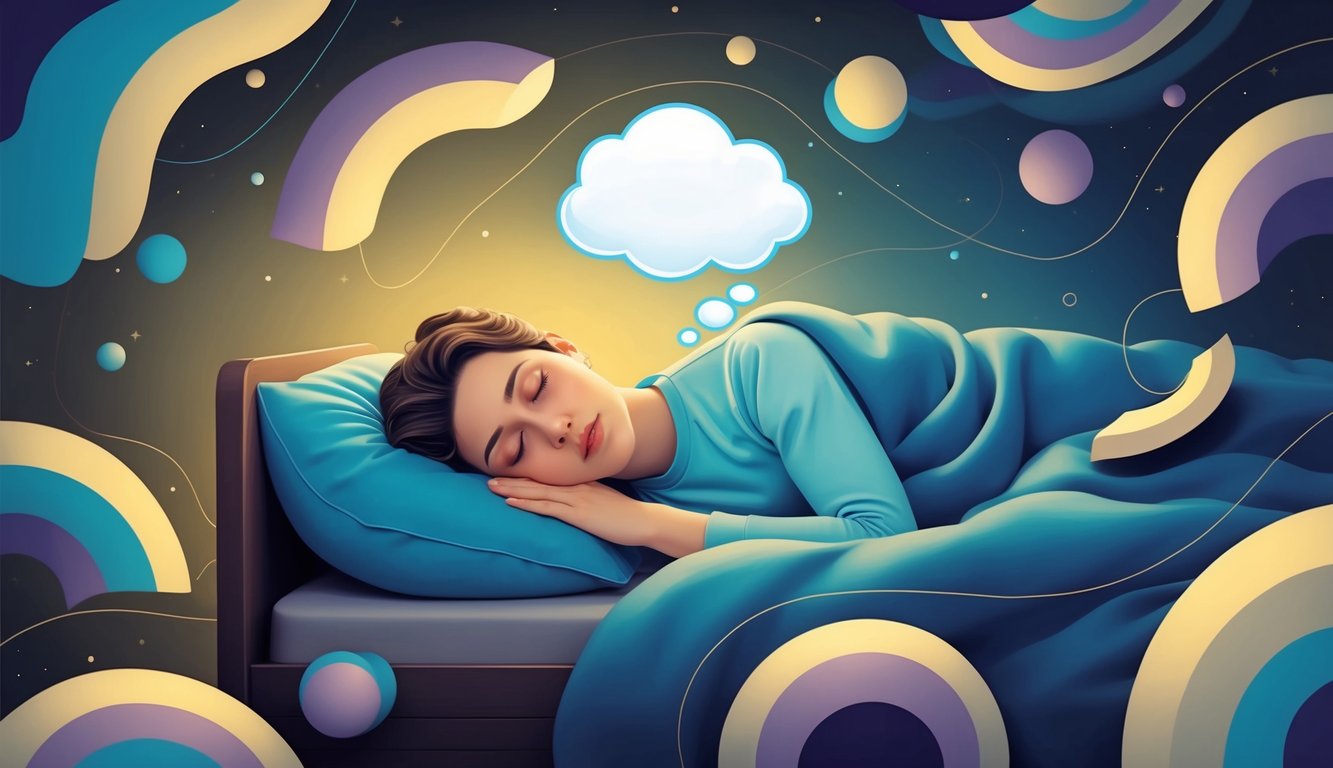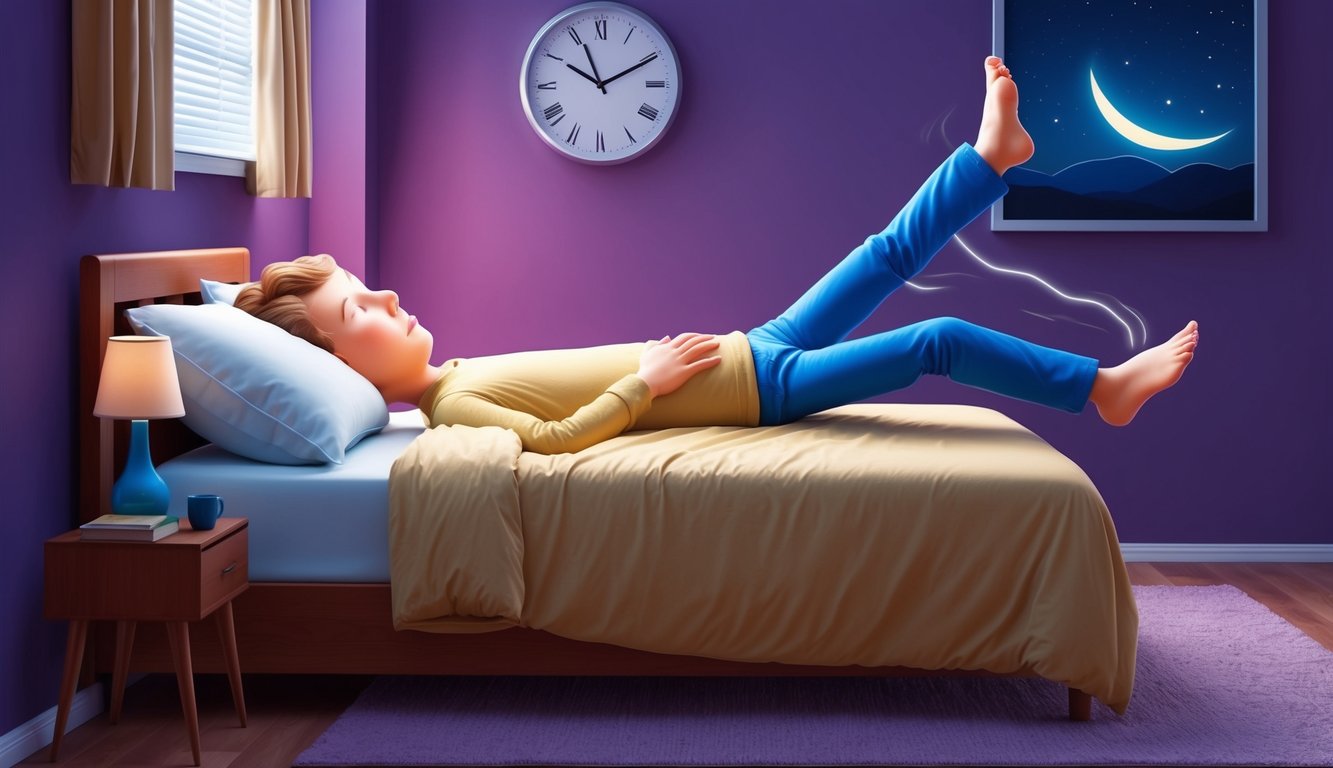Align Your Life with Your True North
The Power Quadrant System decodes your natural talents and pinpoints the career, timing and relationships that let you earn more, love deeper, and wake up eager for the day.
- Uncover your #1 high-income strength
- Draw in partners who raise your energy
- Work when your body’s clock is in “flow”
Ever wondered why you dream? It’s tied to a fascinating stage of sleep called REM.
Your brain becomes very active during this time, almost as if you were awake. REM sleep and dreaming are closely linked, with most vivid dreams occurring during REM periods.
REM sleep happens in cycles throughout the night.
Your eyes move rapidly, your breathing quickens, and your body becomes temporarily paralyzed.
This paralysis keeps you from acting out your dreams.
Your brain processes emotions and memories during REM sleep, which may explain why dreams can feel so real and meaningful.
While scientists don’t fully understand why we dream, they know it’s important.
REM sleep helps with learning, memory, and emotional well-being.
Some people even practice lucid dreaming, where they become aware they’re dreaming and can control the dream’s events.
Key Takeaways
- REM sleep is when your brain is most active and vivid dreams occur
- Your body becomes paralyzed during REM sleep to prevent acting out dreams
- REM sleep and dreaming play important roles in memory, learning, and emotional processing
Understanding Sleep
Sleep is a complex process with different stages and patterns.
Your body and brain go through important changes during sleep.
Decode Your Personal Success Blueprint
Power Quadrant System shows you the exact career, relationships, and daily rhythm that match your natural DNA—so you earn more, work happier, and connect deeper.
- Pinpoint your #1 money-making talent
- Erase conflict & attract ideal partners
- Multiply productivity with perfect timing
Let’s look at how sleep works and why it matters for your health.
Stages of Sleep
Your sleep has two main types: non-REM and REM sleep.
Non-REM sleep has three stages:
- Stage 1: Light sleep, easy to wake up
- Stage 2: Deeper sleep, body temperature drops
- Stage 3: Deep sleep, hard to wake up
During deep sleep, your body repairs itself.
You spend more time in deep sleep early in the night.
As you sleep, you cycle through these stages.
Non-REM vs. REM Sleep
Non-REM sleep is when your body rests and recharges.
Your breathing and heart rate slow down.
Your muscles relax.
Tap Into Your Built-In Success GPS
The Power Quadrant System deciphers your genetic blueprint so you can lock onto the career, income and relationships that feel effortless—and wildly rewarding.
- Zero in on your natural high-earning genius
- Sync with partners who boost your vibe
- Wake up driven, finish days fulfilled
This helps you feel refreshed when you wake up.
REM sleep is when you dream.
Your brain is very active during REM sleep.
Your eyes move quickly, and your body is paralyzed.
REM sleep helps with learning and memory.
You need both types of sleep to be healthy.
Non-REM sleep helps your body, while REM sleep helps your mind.
Sleep Cycle Patterns
Your sleep follows a pattern called sleep cycles.
Each cycle lasts about 90-110 minutes.
A typical night has 4-6 cycles.
Here’s what a sleep cycle looks like:
- Light sleep (Stage 1 and 2)
- Deep sleep (Stage 3)
- REM sleep
As the night goes on, you spend less time in deep sleep and more time in REM sleep.
Your last cycle might be mostly REM sleep.
Understanding these patterns can help you plan your sleep better.
Try to sleep for complete cycles to feel more rested when you wake up.
The Phenomenon of REM Sleep
REM sleep is a fascinating stage of your nightly rest.
Your body and brain go through some unique changes during this time.
Let’s explore what happens and how your brain behaves in REM sleep.
Characteristics of REM Sleep
During REM sleep, your eyes move quickly under your eyelids.
This rapid eye movement gives this sleep stage its name.
Your breathing becomes irregular and may speed up.
Your heart rate also increases.
Interestingly, your body becomes temporarily paralyzed.
This keeps you from acting out your dreams!
REM sleep happens in cycles throughout the night.
Each cycle lasts about 90 minutes.
As the night goes on, REM periods get longer.
You spend about 25% of your sleep time in REM.
It’s crucial for memory, learning, and emotional processing.
Brain Wave Activity During REM
Your brain is very active during REM sleep.
In fact, it’s almost as active as when you’re awake! Brain wave patterns in REM are similar to when you’re awake.
You’ll see fast, low-amplitude waves on an EEG during REM.
These are called “desynchronized” patterns.
They look very different from the slow waves of deep sleep.
Different parts of your brain become active.
The visual, motor, and emotional areas light up.
This might explain why dreams can be so vivid and emotional.
Your prefrontal cortex, which handles logical thinking, becomes less active.
This could be why dreams often don’t make sense!
Dreaming During REM Sleep
Dreams happen most often during REM sleep.
They can be strange, scary, or fun.
Your brain is very active during this time.
Content and Purpose of Dreams
During REM sleep, you may have vivid dreams.
These dreams can feel real and intense.
Your brain creates stories and scenes that mix memories, feelings, and imagination.
Dreams might help you:
• Process emotions
• Solve problems
• Learn new things
Some scientists think dreams prepare you for real-life challenges.
Others believe they help sort through the day’s events.
Your dreams can be about anything – flying, falling, or being chased.
Many people seek dream interpretation insights to understand the hidden meanings behind their dreams.
Analyzing dreams can sometimes reveal fears, desires, or unresolved emotions from daily life.
Whether mysterious or ordinary, dreams remain a fascinating window into the subconscious mind.
Sometimes you might remember your dreams clearly.
Other times, you forget them as soon as you wake up.
Keeping a dream journal can help you recall more of your dreams.
Vivid Dreams and Nightmares
REM sleep can bring very vivid dreams.
These feel real and detailed.
You might see bright colors or hear clear sounds in your dream.
Nightmares are scary dreams that can wake you up.
They often happen during REM sleep too.
Common nightmare themes include:
- Being chased
- Falling
- Losing something important
Nightmares can make you feel afraid or upset.
But they’re normal and usually harmless.
If you have a lot of bad dreams, try to relax before bed.
Avoid scary movies or stressful talks late at night.
Some people have lucid dreams.
This means you know you’re dreaming while it’s happening.
You might even be able to control parts of your dream.
Health and REM Sleep
REM sleep plays a big role in your health.
It affects both your mind and body in important ways.
Let’s look at how REM sleep connects to certain sleep problems and your overall wellbeing.
Sleep Disorders Involving REM
REM sleep behavior disorder is when you act out your dreams.
Your body doesn’t stay still like it should during REM sleep.
This can be dangerous for you and your bed partner.
Narcolepsy is another REM-related problem.
You might fall asleep suddenly during the day.
You could even have dream-like hallucinations while awake.
Sleep apnea can also mess with your REM sleep.
It makes you stop breathing for short times at night.
This can cut into your REM sleep and leave you tired.
REM Sleep and Overall Health
Getting enough REM sleep is key for your brain health.
It helps you learn and remember things better.
REM sleep also supports your emotional balance.
Your overall health depends on good REM sleep too.
It can affect your:
- Immune system
- Heart health
- Weight control
- Mood
Poor REM sleep might even raise your risk for some health issues.
These could include diabetes and depression.
For kids and teens, REM sleep is super important.
It helps their brains grow and develop the right way.
So make sure the young ones in your life get enough sleep!
Developmental Aspects of REM Sleep
REM sleep plays a crucial role in brain development and sleep behavior.
It changes significantly as we grow from infancy to adulthood.
REM Sleep in Infants and Adults
As a newborn, you spend about 50% of your sleep time in REM sleep.
This is much higher than adults, who typically have 20-25% REM sleep.
Your brain is very active during this stage, which helps with brain development.
In infancy, your REM sleep periods are shorter but more frequent.
As you grow, these periods get longer but less frequent.
This change happens gradually over the first few years of life.
REM sleep is important for all mammals, not just humans.
In many species, babies are born with their eyes fused shut.
During REM sleep, you might notice their eyes moving under their eyelids.
This is called rapid eye movement.
Your sleep patterns keep changing as you get older.
As an adult, you have more deep sleep in the first part of the night.
REM sleep becomes more common in the early morning hours.
Psychological Effects
REM sleep plays a big role in your mental health and feelings.
It helps process emotions and can affect anxiety levels.
Let’s look at how REM sleep impacts these areas of your mind.
REM Sleep and Emotional Health
During REM sleep, your brain works on processing emotions.
This helps you deal with tough experiences and memories.
When you get enough REM sleep, you may:
• Feel more balanced emotionally
• Handle stress better
• Have improved mood
REM sleep also helps with memory.
Your brain stores important info and gets rid of stuff you don’t need.
This keeps your mind sharp and ready to learn new things.
If you don’t get enough REM sleep, you might feel grumpy or have trouble focusing.
Your emotions could be all over the place.
It’s like your brain didn’t have time to sort through your feelings.
REM Sleep and Anxiety
REM sleep can affect how anxious you feel.
When you get good REM sleep, you’re often less worried and stressed.
Your brain has time to process fears and concerns while you rest.
Some studies show that people with anxiety often have disrupted REM sleep.
This can make anxiety worse.
It’s like a cycle – poor sleep leads to more worry, which leads to worse sleep.
To help ease anxiety, try to:
• Stick to a regular sleep schedule
• Create a calm bedtime routine
• Avoid screens before bed
Remember, everyone’s sleep needs are different.
If you’re worried about your sleep or anxiety, it’s okay to talk to a doctor.
They can help you find ways to improve your rest and feel better.
Sleep Hygiene and REM Sleep
Good sleep habits can boost your REM sleep.
A comfy sleep space and helpful tools can make a big difference too.
Improving Sleep Quality
You can do a lot to get better REM sleep.
Try to go to bed and wake up at the same time each day.
This helps your body’s clock.
Avoid caffeine and alcohol close to bedtime.
They can mess with your sleep cycles.
Exercise during the day can help you sleep better at night.
But don’t work out too close to bedtime.
It might keep you up.
A warm bath before bed can help you relax and fall asleep faster.
Eating big meals late at night can hurt your sleep.
Try to eat dinner a few hours before bed.
If you’re hungry later, have a light snack.
Sleep Environment and Tools
Your bedroom should be dark, quiet, and cool.
This helps your body know it’s time to sleep.
Blackout curtains can block light that might wake you up.
A comfy mattress and pillow are key for good sleep.
They help you relax and fall asleep faster.
Sleep trackers can show you how much REM sleep you’re getting.
They can help you see if changes in your habits are working.
White noise machines can mask sounds that might wake you up.
Some people find them very helpful.
Earplugs or a sleep mask might also help if your room isn’t totally dark or quiet.
Lucid Dreaming
Lucid dreaming is a fascinating state where you become aware that you’re dreaming while still asleep.
This unique experience allows you to interact with and control your dream environment.
The Experience of Lucid Dreams
When you have a lucid dream, you’re fully conscious within the dream world.
You can make choices, explore your surroundings, and even change the dream’s direction.
It’s like being the director of your own movie!
Lucid dreams usually happen during REM sleep, the stage where most vivid dreams occur.
Your brain activity during a lucid dream is similar to when you’re awake, but your body remains asleep.
To increase your chances of having a lucid dream, try these tips:
- Keep a dream journal
- Practice reality checks during the day
- Set intentions before sleep
Improving your dream recall is key to lucid dreaming.
The more you remember your dreams, the easier it becomes to recognize when you’re dreaming.
Some people use lucid dreaming for problem-solving, creativity, or overcoming nightmares.
It’s a skill that takes practice, but with patience, you can unlock this incredible world of conscious dreaming.
REM Sleep Behavior Disorders
REM sleep behavior disorder (RBD) is a condition where people act out their dreams physically.
It can be scary for both the person with RBD and their bed partner.
RBD is linked to some brain diseases and needs proper diagnosis and care.
Identifying and Managing RBD
Do you kick, punch, or yell in your sleep? You might have RBD.
People with this disorder move and vocalize during dream-filled REM sleep.
Your bed partner may notice you seeming to fight off attackers or run from danger while asleep.
To diagnose RBD, your doctor will likely ask about your sleep habits and may suggest a sleep study.
During this test, experts will watch your brain waves, eye movements, and muscle activity while you sleep.
Treatment often includes making your sleep space safer.
You might need to:
- Remove sharp objects from your bedside
- Put padding on the floor next to your bed
- Consider sleeping separately from your partner
Your doctor may also prescribe medicine to help control symptoms.
Melatonin or certain anti-anxiety drugs can be helpful.
Relationship with Neurological Conditions
RBD isn’t just a sleep problem – it can be an early sign of brain diseases. Many people with RBD go on to develop conditions like Parkinson’s disease.
This link makes RBD important for early detection of these disorders.
If you have RBD, your doctor might watch you closely for signs of:
- Parkinson’s disease
- Lewy body dementia
- Multiple system atrophy
These conditions can show up years after RBD starts.
Regular check-ups can help catch them early.
Your doctor might suggest tests to look for early signs of these diseases.
While this link exists, not everyone with RBD will develop a brain disease.
Still, it’s good to be aware and work closely with your healthcare team.
Techniques for Dream Recollection
Remembering your dreams can be tricky, but there are ways to improve your recall.
By using specific methods, you can boost your ability to remember vivid details from your nighttime adventures.
Dream Journals and Recollection Strategies
Keeping a dream journal is one of the best ways to enhance your dream recall.
Place a notebook and pen by your bed.
When you wake up, jot down anything you remember.
Even if it’s just a feeling or a single image.
Try to write in the present tense, as if you’re still in the dream.
This can help bring the experience back to life.
Set an intention before you go to sleep.
Tell yourself, “I will remember my dreams tonight.” This simple act can prime your brain for better recall.
Wake up slowly and keep your eyes closed.
Stay still for a few moments and let the dream images float back to you.
Quality sleep is crucial for vivid dreaming.
Make sure you’re getting enough rest each night.
Try waking up during different sleep cycles.
Set an alarm for 4.5, 6, or 7.5 hours after you fall asleep.
These times often coincide with REM periods, when dreams are most vivid.
Practice makes perfect.
The more you focus on remembering your dreams, the better you’ll become at it.












